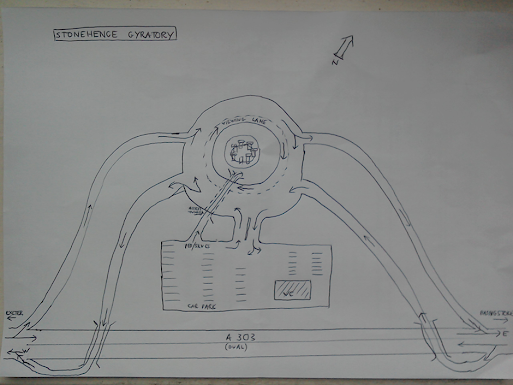Some Thoughts on the Great Stonehenge Debate
There has been much argument and a marked polarisation of views recently on the question of what to do about that well-loved icon of British pre-history, Stonehenge.
The principal issue seems to be the congestion on the nearby A303 (the ‘road to the sun’ as it often prosaically called) and how to relieve it.
Users of this busy single-carriageway arterial cross-country road
linking the M3 with the A30 to the East of Exeter regularly endure tailbacks
several miles long around Stonehenge during the peak holiday season. The fact
that has been allowed to remain a two-lane road in this day and age almost
beggars belief, and a relief road scheme is urgently needed. (see Figure 4)
A bypass of some description has been under
consideration for the last 50 years, but until very recently no progress had been
made, due largely to the efforts of the environmental lobby.
Several news outlets reported last week that
the plans for a road tunnel, originally approved in 2020 then challenged in the
courts, had been approved. However,
due to severe financial cutbacks which extend to infrastructure project funding,
it is possible that the plans for the tunnel may yet be scrapped by HMG on costs
grounds. Is there perhaps a better and less costly solution to the problem ?
Possible solutions
A quick look at the monument’s layout reveals it
to be almost a perfect circle, surrounded by a circular ditch (See Figure 1). Viewed from this
vantage point therefore, one solution immediately presents itself…a roundabout….
We in the UK have a great tradition of radical
roundabout design. The Milton Keynes system of interlocked islands is the ‘envy
of Europe’ and some would like to see the MK network designated as the 9th
wonder of the world. Not only would a new and revolutionary design at
Stonehenge cement our position as a world leader in roundabout design, but it
would stop all those endless arguments over tunnels…and save a whale of a lot
of infrastructure cash into the bargain.
A relatively simple design should suffice and could
be landscaped to harmonise with the existing layout of the monument, as well as
providing much-improved facilities for visitors. The moat-like ditch already surrounding
the stones would provide a convenient delimiter for the new circular portion of
the road with a feeder slip-road section from the existing A303 at each end of
the roundabout (see Figure 3).
To cater for visitor traffic, and service
vehicle access to the monument when required, an underpass could be constructed
on the south eastern side of the new road layout. The existing course of the
A303 could be left as it is and a new dual carriageway constructed along its
length for ca 2 miles either side of the monument with feeder entry and exit
slip-roads at either end to allow visitor access to the site.
This upgrade to the A303 would undoubtedly
relieve congestion around Stonehenge, and improve access to the monument. It should also avoid the thorny problem of driver
distraction when attempting to view the monument from the main route. A far
better view would be available from the roundabout, and this could be obtained
without the need to stop at the visitors centre. This new structure would also
block off the direct view from the road, while freeing up the existing space
taken up by the current parking and visitor facilities to the northwest of the
monument.
The novel design could also include an inner
drive-through viewing lane at the inner edge of the roundabout carriageway for
visitors preferring to remain in the comfort of their vehicles, thus reducing
footfall and minimising environmental damage to the monument’s surroundings.
Using ANPR, charges could be levied from drive-through only visitors
automatically, thus ensuring the existing tourist revenue stream is maintained.
The drive-through element and the resulting improved traffic flow should also
provide an opportunity for an increase in visitor numbers and hence augment
revenues further.
The capital cost of such a scheme would be
certain to undercut the estimated £1.7Bn required for construction of the
tunnel, which with inflation would be expected to over-run by some margin
before construction was complete in the late 2020s. Apart from a small
single-lane pedestrian and service access underpass, the design involves only
two significant new structures – the bridges carrying the slip-roads to and
from the westbound carriageway of the A303.
This should sit well with those holding the
infrastructure purse-strings and leave plenty of budget to spare for
landscaping and site restoration. Any further savings against budget could be
used to extend the dualling of the A303 beyond the initial 2-mile planned stage
1 upgrade. The Gyratory project as shown could also be completed far more
quickly than a complex tunnel build, and hence provide must faster congestion
relief from the present periodic traffic chaos.
Would this innovative alternative scheme still raise objections from the opposition ? - of course it would, but I suspect less so than the tunnel proposal, particularly since this scheme has now been approved in principle, and now sits like the 'Sword of Damocles' over objectors' heads.
Improving access to
a popular visitor attraction in a way that avoids additional traffic congestion always involves additional construction work to
accommodate the extra numbers, so a compromise between leaving things as they
are and upgrading them will undoubtedly be necessary – sooner or later.
If the alternative is an expensive and highly
controversial tunneling scheme, then perhaps this design would be acceptable as the
lesser of two evils ?
In the words of the now famous Meerkats….s i m p
l e s…
(Editor’s Note: For those environmentalists of
a nervous disposition, please note publication date)
First
published 1/4/23
Figure 1: Stonehenge at Sunset
Figure 2: Satellite Image of the Monument March
2023
Figure 3: Suggested Design for 'Stonehenge Gyratory'
Figure
4: The Traffic Problem




Comments
Post a Comment